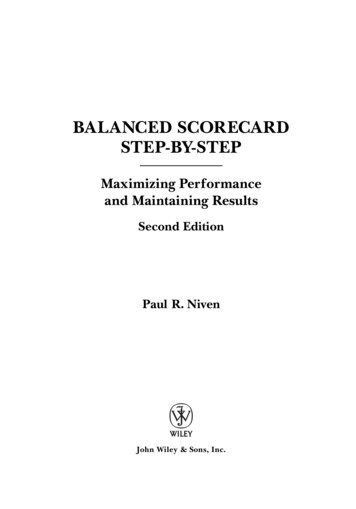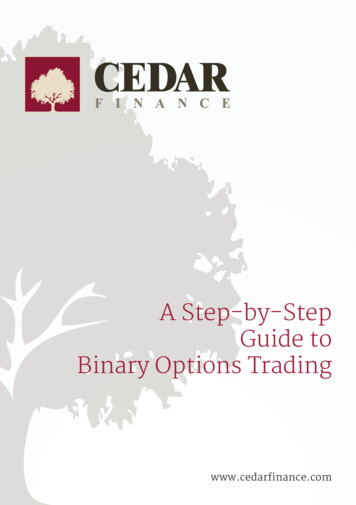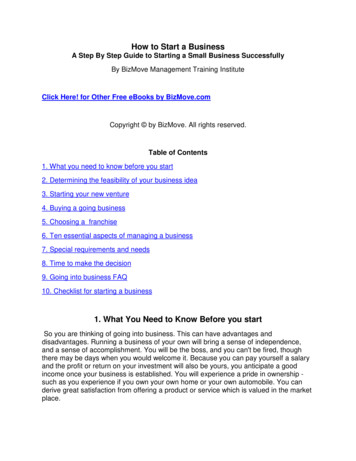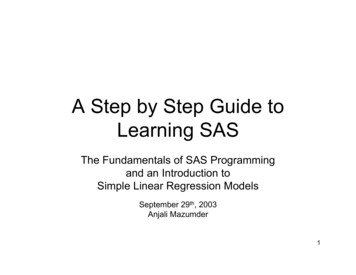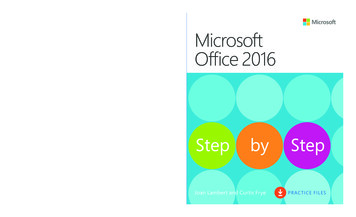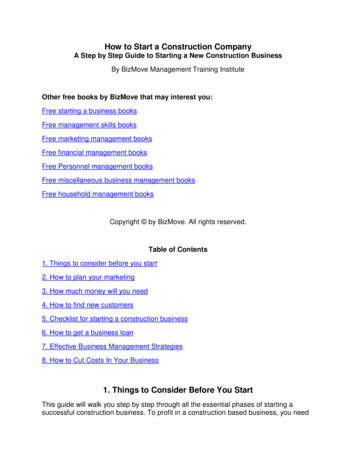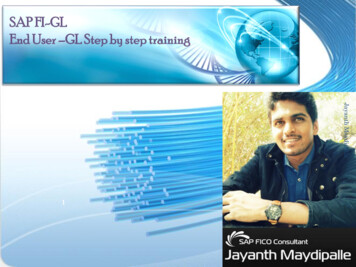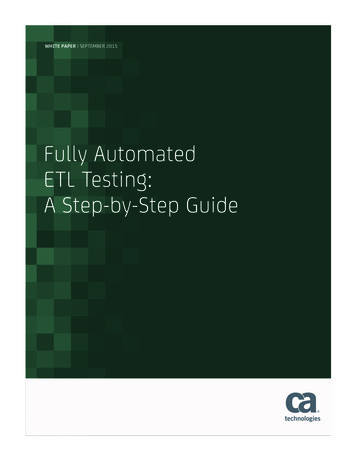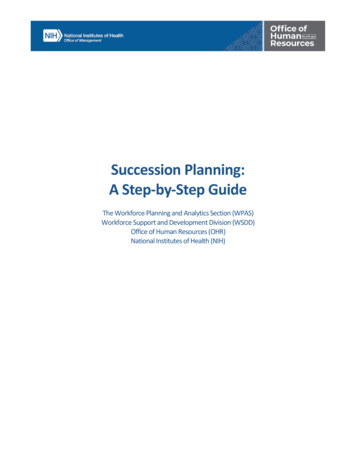
Transcription
Succession Planning:A Step-by-Step GuideThe Workforce Planning and Analytics Section (WPAS)Workforce Support and Development Division (WSDD)Office of Human Resources (OHR)National Institutes of Health (NIH)
ContentsIntroduction to succession planning. 3What is succession planning and why is it important? . 3The risks of not succession planning . 3Get buy in for succession planning using analytics . 3Leverage positions, not people . 5Steps in succession planning . 5Identify roles and responsibilities . 51.Identify critical and vulnerable positions . 62.Develop eligibility requirements. 63.Identify a talent pipeline . 74.Nominate successors from the qualified positions. 75.Create an action plan to prepare successor(s) . 86.Evaluate the succession plan. 8Appendix A . 9Succession planning templates and resources. 9NIH HR Systems Tools . 9Contact Information . 92
Introduction to succession planningWhat is succession planning and why is it important?Succession planning is the process of identifying very important positions in the organizationand creating a talent pipeline, by preparing employees to fill vacancies in their organization asothers retire or move on. A successor is an employee with the knowledge, skills, and abilities tofill a vacant position until a permanent replacement can be identified.Succession planning helps ensure business continuity and performance, particularly duringtimes of shifting leadership and change. Even when there is no identifiable successor within anorganization, succession planning can help identify the knowledge, skills and training needed ina future external candidate.The risks of not succession planningHaving no identifiable succession plan for critical roles poses an enormous risk to theorganization.These risks include: Loss of mission critical knowledge that may never be recovered. Naming a successor who lacks personal drive, commitment,knowledge, training or skills needed to perform the jobsuccessfully. Significant loss of time spent getting a new successor up tospeed. Potential disruptions to workplace processes, workflows, andprotocols.If your organization lost itsmost critical employeestoday, would you have asuccessor with theknowledge, training &skills needed to fill theirshoes?Get buy in for succession planning using analyticsYour workforce data has a story to tell! Leveraging workforce data can help you visualize yourworkforce. For example, how much of your workforce is currently eligible to retire? Using datato provide a visual representation of the workforce is a highly effective strategy for garneringsupport and interest in succession planning.Consider summarizing workforce data into a snapshot for your leadership. Include the snapshotduring workforce discussions, strategic planning, and as you discuss your mission, to reinforcethe importance of workforce planning. To see a sample snapshot, or for help building your ownworkforce analytics, contact the Workforce Planning and Analytics Section (WPAS) in theOffice of Human Resources using our mailbox: NIH-WORKFORCE-PLANNING@nih.gov.3
Data points to consider in your workforce snapshot include:Data PointData Insights for Succession PlanningEmployee onboard count &Provides visual representation of the employees onboard, theirretirement eligibilitydistribution across the organization and how much of the workforce isretirement eligible.Years of serviceIdentifies employees who may be closer to retirement and have moreinstitutional knowledge to capture.GS level distributionIdentifies whether there is a junior pipeline of employees for successionplanning. May also help identify critical positions.Separations and AccessionShows hiring and separation trends for forecasting future staffing needs(hiring) counts over yearsacross different scenarios.Retirement eligible byIdentifies demographics areas that may experience future turnover anddemographics (such as series) may be vulnerable to knowledge loss without a successor.Time stayed past retirementProvides insight into how long employees typically stay past theirretirement eligibility date.Separation and accessionIdentifies areas of high turnover to prioritize for succession planningtrends by seriesactivities.Time to hireHelps determine which positions take longest to fill and are thereforemore vulnerable when turnover occurs.Below is a sample snapshot of what some of the above data points might look like visually:4
Leverage positions, not peopleIn the civil service system, no determinations of who will succeed an employee are made untilall qualified candidates are provided equal opportunity to apply and be considered for theposition. Situations where a candidate is “pre-determined” before the competitive selectionprocess is considered “pre-selecting”, or “pre-positioning”, and should be avoided. It is moreeffective and a best practice to determine which positions are best qualified to succeedanother position rather than the individual people filling those positions at any given time.Focusing on the qualified positions rather than people offers many benefits, such as: Fostering a culture of trust and fairness. A competitive process that promotes diversity and inclusion. Discovering unexpected and highly qualified candidates that may emerge through thecompetitive process. Reduced risk that a pre-selected candidate may leave the organization before they’veassumed the successor position. An increase in employee engagement as a result of the creation of career paths.Steps in succession planningIdentify roles and responsibilitiesSuccession planning is not just a one-time administrative task, it requires continued employeedevelopment. The roles and responsibilities you may want to consider include:Project ManagerStakeholdersSenior leaders to help endorse theproject and identify mission criticalroles for succession plans.An employee to kick off the basicsteps in the project and help track theprogress of the plan.IncumbentPotential SuccessorsThe potential successor positions whichwill participate in developmentalactivities towards successor positions.The expert to share theirknowledge and skills in the rolebeing planned for.5
1. Identify critical and vulnerable positionsThe first step in succession planning is to choose positions most in need of successors. Twofactors to consider when prioritizing are the positions vulnerability and criticality.1. First, determine which positions have no identifiable successor, these positions are mostvulnerable to knowledge loss.2. Next, consider the impact each position has on theDetermining mission critical positionsorganization’s mission; if a vacancy in a position wouldcan be time consuming and difficult toimpact the organization’s ability to accomplish theirreach agreement on. Identifyingvulnerable positions first makes themission it can be classified as critical. Critical positions atprocess easier because it reduces theNIH often extend beyond senior leadership roles to includenumber of potentially critical positionstechnical and scientific positions.to assess.The matrix below will help you visualize how to identify positions in need of successionplanning. Use the excel Succession Planning Tracker Template available in Appendix A toperform this step for your own organization. You may also consider whether there is a lack ofcandidates available externally for recruitment. Positions that have high vulnerability and highcriticality pose the highest risk.Vulnerability:No successor position identified for this ulnerabilityCriticality:Impact ofthepositionon owCriticalityLowRiskLowRiskModerateRisk2. Develop eligibility requirementsOnce you’ve identified positions in need of a succession plan, the next step is to develop aprofile of the position and the performance expectations; this will help your organizationdetermine who has the experience to take on the role. Use the questions below, along with theSuccession Planning Profile Template available in Appendix A to create a profile for theposition. You may also choose to use the Transition Planning Interview Guide (Appendix A) inthe toolkit to meet with the position incumbent and gather information.Questions to consider as you develop eligibility requirements: What selection criteria would be used to fill this position if it were vacant? What knowledge, skills, abilities and competencies are needed in this position toachieve success?6
3. Identify a talent pipelineUsing the profile you’ve created, you can now identify positions that are well-suited totemporarily transition into the successor position should a vacancy arise. These positions mayalso be qualified to apply for the successor position when the announcement is made. Use thequestions below to help you assess successor positions.Consider sharing theQuestions to consider:succession requirements What are the best aligned duties between the two positions?openly with employees to Does the position have similar day to day experiences in theencourage transparency,trustand engagement withfunctional areas and tasks performed for the successor role?the process. What are the gaps between the two roles? Does the position cultivate the core competencies needed to performthe successor role?4. Nominate successors from the qualified positionsThe next step is to identify employees in the qualified positions who could temporarily fill thevacancy and potentially apply as candidates for the position should the need arise.Consider inviting leaders to nominate qualified employees for development in a successionplan, but also invite employees to express their interest as well. Making the opportunity andcandidate requirements transparent cultivates equity and trust in the process, and helpsemployees see potential career trajectories for their role. Work with your leadership todetermine a final list of candidates whose performance and job description makes them eligiblefor development into the successor role.Consider the following qualifications: Sustains high performance. Demonstrates a measurable positive impact on the organization’s performance. Is recognized by colleagues, customers and managers as a future leader. Is a good fit with the organizational culture. Demonstrates the organization’s values. Innovates to improve their functional area.It is important to remind candidates that the position is not guaranteed to any one candidatebecause it depends on performance, and an employee may be removed from considerationshould their performance fall below expectations. The civil service rules on competitive hiringwill still apply for final candidate selection.If you do not have any eligible candidates in positions well-suited for the successor position,consider incorporating your succession qualifications into your recruitment strategy. You mayalso want to evaluate whether gaps exist in your learning and development programspreventing people from reaching career opportunities.7
5. Create an action plan to prepare successor(s)Creating a developmental plan for potential successors helps to identify meaningfulopportunities for growth. The following list of learning and development opportunities mayhelp you create a succession development plan, but it is also important to ask the incumbent toidentify opportunities for the successor as well.Successor development opportunities include:1. Creating a succession development plan with training and learning opportunities thatare aligned with the successor position. Consider opportunities available through NIHLeadership Development programs.2. Participating in the functional areas of the incumbent’s role, especially areas outside ofthe incumbent’s current experience.3. Mentoring from the incumbent.4. Providing coaching opportunities.5. Acting for the incumbent while they are away from work.6. Working on special projects or opportunities to stretch skills into aligned areas.7. Dual incumbency opportunities when the incumbent transitions out of their role.6. Evaluate the succession planBy evaluating your organization’s succession planning efforts each year, you can continuallyimprove your succession planning strategy and your organization’s effectiveness.When evaluating your succession planning program, consider the following:1. Your organization’s bench strength prior to suc
Identify critical and vulnerable positions . When evaluating your succession planning program, consider the following: 1. Your organization’s bench strength prior to succession planning versus after succession planning started. 2. The number of qualified “ready now” candidates compared to before succession planning started. 3. Improvements in the way your organization develops .

